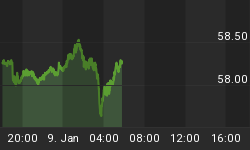Gold and silver mining stocks have sold off by roughly 30% from their 52-week highs based on the PHLX Gold/Silver Sector Index (XAU) and by roughly 32% based on the Amex Gold Bugs Index (HUI). In comparison, gold is down approximately 14% from its nominal all time high in 2011 while silver is down approximately 37%.

The XAU / Gold ratio suggests that gold and silver miners are oversold. In fact, the shares of some companies are trading below their net asset values.
Metal Price Trends
Despite having come down from their 2011 highs, gold and silver prices have shown stubborn resistance below $1650 for gold and below $30 for silver. When prices have broken through these levels, the metals have rebounded. Unlike the breakdown in gold and silver prices after the 1980 mania, gold and silver prices are currently stabilizing at lower levels.

Although prices remain volatile from day to day, current prices appear to reflect a trading range that suggests a consolidation.
Adjusting the Price of Gold
Adjusted using the current U.S. Bureau of Labor Statistics (BLS) Consumer Price Index (CPI), the 2011 highs in gold and silver prices appear similar to the bubble of 1980, but the BLS has changed the way that the CPI is calculated since 1980.

Based on the 1980 formulation of the CPI, which is still calculated by economist John Williams of Shadow Government Statistics, gold and silver prices do not appear to have been in a bubble in 2011.

In addition to changes in the calculation of CPI since 1980, the Federal Reserve's funds rate is currently close to 0% rather than the 1980 average of 13.36% and the Federal Reserve cannot realistically raise rates in the face of weak economic fundamentals, overleveraged banks and excessive debt levels. Unlike the 1980s, the world reserve currency status of the U.S. dollar is slowly deteriorating and the future of the Euro, which was introduced in 1999, is unclear.
Prices Measured in What?
Artificially low interest rates, government deficit spending and quantitative easing by central banks, e.g., the Federal Reserve's central bank liquidity swap lines and the European Central Bank's (ECB) Long Term Refinancing Operation (LTRO), expand the money supply independent of sustainable economic activity and population growth. When the money supply expands in a disproportionate way, the value of money falls and prices rise as a result, i.e., because of currency debasement.
Currency debasement will continue in the foreseeable future. Current monetary and fiscal policies in the U.S., the United Kingdom, the European Union and Japan, prevent large, overleveraged banks from failing and allow high levels of government borrowing to continue despite higher debt levels and lower tax revenues resulting from weak or deteriorating economic fundamentals.

Given the economic and financial condition of Western countries, as well as Japan, it is not practicable for monetary expansion to abruptly cease or for money supplies to be quickly brought back in line with sustainable economic activity and population growth. In other words, there is no practical way for central banks to stop currency debasement without bank failures and sovereign defaults.
Value Versus Psychology
With gold and silver prices at or above current levels, some gold and silver mining stocks are severely undervalued. However, exploration companies without substantial defined resources and producers that have relatively high production costs or relatively low grade deposits are less likely to rebound when mining stocks begin to recover.
Metals prices stuck in a trading range and higher oil prices, thus, higher energy costs, are crushing the prices of exploration stocks and impairing the share prices of producers with higher production costs or lower grade deposits. In contrast, the share prices of gold and silver mining companies achieving consistent growth in resources and reserves, production, revenues and cash margins can be expected to rebound vigorously when confidence in metals prices firms. Cash flow will separate the wheat from the chaff.
The question on the minds of many investors is "Where is the bottom?" Many fund managers have pulled out of gold stocks after making little progress in the past year or more, and there is a growing sense of despair in the marketplace. At the same time, investors who pulled out are afraid to get back in. What is important about the pervasive negative sentiment is that it is a key indicator of a market bottom. At the top of the market, there are a hundred reasons to buy and, at the bottom of the market, there are a hundred reasons to sell. If psychology is any guide, gold stocks have hit bottom.
















